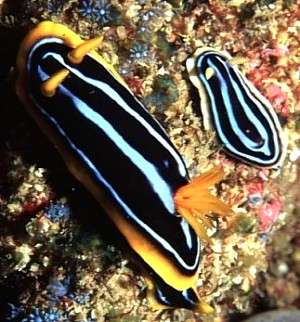Colour variation
May 9, 2000
From: Nerida Wilson

Hi Bill,
This picture of an adult and juvenile Chromodoris kuiteri, seems to show how the intensity of some colours changes with age. I think Valda Fraser mentioned this in reference to Chromodoris cf geminus. Is this happening
a) only in some groups eg. Chromodoris?
b) only with some colours eg. orange?
Does anyone else have similiar examples that may shed some more light on the matter?
Thanks
Nerida.
nwilson@zen.uq.edu.au
Wilson, N., 2000 (May 9) Colour variation. [Message in] Sea Slug Forum. Australian Museum, Sydney. Available from http://www.seaslugforum.net/find/2228Dear Nerida,
I'm sorry I didn't post this question earlier. I put it to one side to look out some photos but haven't found them so let's see what others have to say.
Basically I don't think age usually has much to do with colour intensity once animals have passed quite a small stage. Hatchlings, and recently settled young certainly have very pale colouration but that is usually through lack of pigment rather than presence of very pale pigment. I think in your example, the smaller animal will have the pale orange colour throughout its life. The black pigment is certainly as intense as in the larger animal. That is not to say that in some species such as Chromodoris cf geminus the colour does become more intense as they grow. I just don't think there is a standard rule.
I will try and find some juvenile examples.
In the meantime has anyone else any ideas or examples?
Best wishes,
Bill Rudman.
